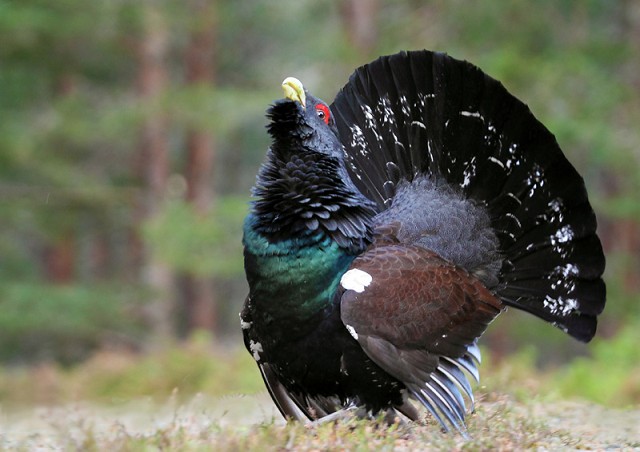Capercaillie continue to struggle
The population of one of Scotland's most iconic species, the Capercaillie, remains under serious threat, according to newly-released figures from RSPB Scotland and Scottish Natural Heritage (SNH).
This most recent Capercaillie survey, carried out over the 2009–10 winter, estimated a population of 1228 individuals, three quarters of which are confined to Badenoch and Strathspey, the species' stronghold. Once extinct in the UK, Capercaillie were reintroduced to Scotland, beginning in Perthshire in the 1830s.

Capercaillie, undisclosed site, Highland (Photo: John Fielding)
As recently as 1970 there were thought to be as many as 20,000 individual birds, but by the early 1990s, when the first formal surveys were conducted, numbers had declined sharply, particularly in Deeside and Perthshire. The last census, conducted in 2004, found that there were an estimated 1,980 birds remaining in Scotland. This compared to an estimate of just 1,073 birds in 1988–89, which triggered targeted conservation action for the species.
To save the Capercaillie from a second UK extinction, conservationists and land-managers have undertaken intensive work aimed at halting and reversing its declines. Efforts have focused on creating, or improving, the native pine forest and blaeberry habitat it favours, legal predator control and minimising disturbance in sensitive areas — for example around leks — from people and dogs.
Research indicated that many Capercaillie are killed flying into forestry deer fences, and collisions can significantly increase adult Capercaillie mortality. To combat this, fences at key Capercaillie sites have been removed, or marked to make them more visible.
Capercaillie require warm and dry weather during the brooding period in June to breed successfully. Consecutive wet springs in 2007 and 2008, together with poor habitat quality, quantity and connectivity, and deaths from fence collisions, predation and disturbance, are all playing their part in keeping the population at a low level.

Capercaillie, undisclosed site, Highland (Photo: Rob Sewell)
However, without these continued efforts by private landowners, countryside users, and conservationists supported by the Scottish Government, it is likely that the Capercaillie population would have been much lower. This positive management and action has also come as a result of the Capercaillie Species Action Framework (SAF) and the Scottish Rural Development Programme (SRDP).
Stuart Housden, Director of RSPB Scotland, said: "It is disappointing that the Capercaillie has experienced a drop in its numbers in some areas since the last survey was conducted. However, there can be little doubt that this decline would be a good deal worse were it not for all the huge efforts of many public and private forestry managers, gamekeepers and land-managers backed by the European LIFE funding programme, to save this charismatic species. We particularly need to focus our efforts on further habitat creation and positive management for this species, especially in key areas like Deeside and Perthshire where the problems are most acute. This demands concerted and swift action with estate managers and conservation bodies working together to make sure the Capercaillie remains part of the wonderful wildlife that makes Scotland such a special place."

Capercaillie, undisclosed site, Highland (Photo: Rob Sewell)
Dr Sue Haysom of SNH added: "Along with many land-managers we are passionately committed to saving this species. The Capercaillie SAF and SRDP both provide support for habitat creation and management, fence removal or marking and predator control, all of which help Capercaillie. Through the Caper SAF alone we have removed or marked 11.3 km of deer fences thus far, adding to the 220 km dealt with through the Forestry Commission Challenge Fund and 40.6 km through the EU-Life Nature Project. We have also created new and improved existing habitat and witnessed birds making use of these areas. The low breeding success and wet summers of 2007 and 2008 may have counterbalanced some of the benefits of this work, but a few good summers like the one we saw in 2010 and continued conservation action could well turn things round for this amazing bird."

